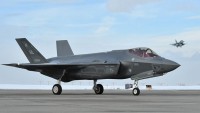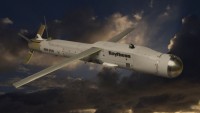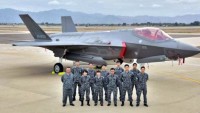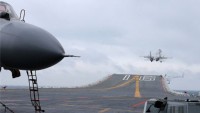US Navy to Develop New and Far Deadlier Air Superiority Stealth Fighter Replacing F-35
| Arthur Dominic Villasanta | | Feb 12, 2017 07:21 AM EST |
(Photo : US Navy) The USS Zumwalt and a Navy F-35.
The U.S. Navy will conduct research studies aimed at developing a true air superiority stealth fighter to succeed the Northrop Grumman F-35 Joint Strike Fighter. It also wants to develop a long-range unmanned strike fighter.
While the F-35 has the measure of both China's Chengdu J-20 low observable fighter now in low rate production, and Russia's Sukhoi PAK FA stealth fighter still under development, the navy has indicated the need to boost this superiority with a fighter designed from the get go to shoot down masses of enemy stealth fighters.
Like Us on Facebook
The F-35 is an all-in-one fighter designed primarily for attack missions with a secondary air superiority role. But thanks to the F-35's superior stealth design and electronics, this fighter has morphed into the premier air superiority fighter for the Navy, the U.S. Air Force and the U.S. Marines.
The Center for Strategic and Budgetary Assessments (CSBA), a U.S. think tank specializing in U.S. defense policy and force planning, recommended the need for a new air superiority fighter in its latest naval future fleet architecture study.
"In contrast to today's multimission strike-fighters, such as the F-35C, the design of these aircraft (the new U.S. fighter) would need to focus mostly on the fighter mission rather than strike, so that they would have the speed, endurance, maneuverability, and air-to-air sensor capability needed for counter-air operations," recommended the report.
Apart from destroying Chinese and Russian fighters, the new U.S. fighter will have to intercept Russian and Chinese strategic bombers before they can launch their anti-ship cruise missiles (ASCMs) at U.S. Navy carrier strike groups.
"With the ranges of air-launched ASCMs increasing to 1,000 nautical miles (1,900 km), (U.S.) ships may not be able to use long-range surface-to-air interceptors such as SM-6s to engage enemy bombers before they can launch their ASCMs," said the report.
"CVW (Carrier air wing) aircraft will need to conduct this counter-air mission. Long range ASCMs also enable an adversary's bombers to launch attacks on the incoming Maneuver Force while the bombers are still protected by shore-based air defenses: defenses that can reach out to about 500 nautical miles (930 km), depending on the target's altitude."
TagsU.S. Navy, air superiority stealth fighter, Northrop Grumman F-35 Joint Strike Fighter, Chengdu J-20, Sukhoi PAK FA stealth fighter, Center for Strategic and Budgetary Assessments
©2015 Chinatopix All rights reserved. Do not reproduce without permission
 F-35 Scores 15:1 Kill Ratio in Red Flag 2017 Air Combat Exercise
F-35 Scores 15:1 Kill Ratio in Red Flag 2017 Air Combat Exercise US Rushes to Arm US Marines’ F-35B Stealth Fighters with Small Diameter Bombs
US Rushes to Arm US Marines’ F-35B Stealth Fighters with Small Diameter Bombs F-35 Stealth Fighter will Revive Japanese Militarism, Alleges China Armed Forces Website
F-35 Stealth Fighter will Revive Japanese Militarism, Alleges China Armed Forces Website U.S. Transforming Japan into Unsinkable Aircraft Carrier Threatening China
U.S. Transforming Japan into Unsinkable Aircraft Carrier Threatening China
EDITOR'S PICKS
-

Did the Trump administration just announce plans for a trade war with ‘hostile’ China and Russia?
-

US Senate passes Taiwan travel bill slammed by China
-

As Yan Sihong’s family grieves, here are other Chinese students who went missing abroad. Some have never been found
-

Beijing blasts Western critics who ‘smear China’ with the term sharp power
-

China Envoy Seeks to Defuse Tensions With U.S. as a Trade War Brews
-

Singapore's Deputy PM Provides Bitcoin Vote of Confidence Amid China's Blanket Bans
-

China warns investors over risks in overseas virtual currency trading
-

Chinese government most trustworthy: survey
-

Kashima Antlers On Course For Back-To-Back Titles
MOST POPULAR
LATEST NEWS
Zhou Yongkang: China's Former Security Chief Sentenced to Life in Prison

China's former Chief of the Ministry of Public Security, Zhou Yongkang, has been given a life sentence after he was found guilty of abusing his office, bribery and deliberately ... Full Article
TRENDING STORY

China Pork Prices Expected to Stabilize As The Supplies Recover

Elephone P9000 Smartphone is now on Sale on Amazon India

There's a Big Chance Cliffhangers Won't Still Be Resolved When Grey's Anatomy Season 13 Returns

Supreme Court Ruled on Samsung vs Apple Dispute for Patent Infringement

Microsoft Surface Pro 5 Rumors and Release Date: What is the Latest?










